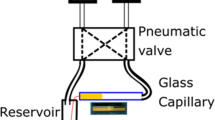Abstract
The purpose of this work is to analyze the various kinds of capillary viscometers that have been used in the past, and to formulate the relation between the measured quantities and the viscosity of the fluid. Three kinds of capillary viscometers are discussed: the steady-state capillary, two capillaries in tandem and the Rankine viscometer. Improved working formulae are derived for every case. Throughout the work the fluid is assumed to be incompressible. However, a short discussion of the correction for compressibility is also provided.
Similar content being viewed by others
Abbreviations
- A(x) :
-
tank cross sectional area (see Fig. 15)
- a :
-
radius of capillary
- A, B, C :
-
constants (see (21))
- G :
-
geometric coefficient (defined in (13))
- g(x) :
-
function in (20b)
- H :
-
driving head (see Fig. 15)
- L :
-
length of capillary
- L 0 :
-
distance from the inlet at which the velocity profile in the feeding tank is parabolic (see Fig. 6)
- L′:
-
L+na (see (12))
- M :
-
molecular weight of the gas
- m :
-
mass flow rate
- m :
-
constant due to inlet correction (see (7))
- m 0 :
-
constant due to inlet correction (see (10))
- n :
-
constant due to inlet correction (see (10))
- p :
-
pressure
- R :
-
radius of feeding tank; universal gas constant
- Re :
-
Reynolds number
- T :
-
temperature
- ū :
-
average velocity in capillary
- V :
-
volume
- xxx0056; :
-
volumetric flow rate
- x :
-
axial coordinate along the capillary
- x 1, x 2 :
-
coordinates along the inlet and exit tanks, respectively (see Fig. 15)
- α :
-
defined in (20a)
- β :
-
defined in (20a)
- Γ :
-
geometric factor (see (5))
- Δp :
-
pressure drop
- ζ :
-
defined in (13)
- μ :
-
dynamic viscosity
- ν :
-
kinematic viscosity
- ρ :
-
density
- τ :
-
efflux time
- ψ(x):
-
function defined in (17)
- *:
-
reference value
- e:
-
exit of capillary
- i:
-
inlet of capillary
- l:
-
exit tank
- u:
-
inlet tank
References
Erk, S., Z. f. tech. Physik 10 (1929) 452.
Barr, G., A Monograph of Viscometry, Humphrey Milford, N.Y., 1931.
Gögüs, Y., Private communication. Details to be published.
Korson, L., W. Drost-Hansen and F. J. Millero, J. Phys. Chem. 73 (1969) 371.
Korosi, A. and B. M. Fabuss, Anal. Chem. 40 (1968) 1.
Schlichting, H. (transl. J. Kestin), Boundary Layer Theory, 6th ed. McGraw-Hill, N.Y., 1968.
Penn, R. W. and E. A. Kearsley, An absolute determination of viscosity using channel flow, Report, Journ. of Res. of the N.B.S., 75A (1971) 553.
Boussinesq, J., Compt. Rend. 110 (1890) 1160, 1238, 1292.
Schiller, L., Z. Angew. Math. u. Phys. 2 (1922) 96.
Goldstein, S., Modern Developments in Fluid Dynamics, vol. I, Clarendon Press, Oxford, England, 1938.
Langhaar, H. L., J. Appl. Mech. 9 (1942) A55.
Sparrow, E. M., S. H. Lin and T. S. Lundgren, Phys. Fluids 7 (1964) 338.
Swindells, J. F., J. R. Coe, Jr. and T. B. Godfrey, J. Res. N.B.S. 42 (1952) 1.
Flynn, G. P., R. V. Hanks, N. A. Lemaire and J. Ross, J. Chem. Phys. 38 (1968) 1954.
Kao, J. T. F., W. Ruska and R. Kobayashi, Rev. Sci. Instr. 39 (1968) 824.
Schmidt, F. W. and B. Zeldin, A.I.Ch.E. 15 (1969) 612.
Prandtl, L. and O. J. Tietjens, Applied Hydro and Aerodynamics, McGraw-Hill, New York, 1939.
Reiman, W., J. Amer. Chem. Soc. 50 (1928) 40.
Dorsey, N. G., Phys. Rev. 28 (1926) 833.
Christiansen, E. B. and H. E. Lemanen, A.I.Ch.E. J. 11 (1965) 995.
Hornbeck, R. E., Appl. Sci. Res., Sec. A. 13 (1964) 227.
Vrentas, J. S., J. L. Duda and K. G. Bargeron, A.I.Ch.E. J. 12 (1966) 937.
Friedman, M., J. Gillis and N. Liron, Appl. Sci. Res. 19 (1968) 426.
Abarbanel, S., S. Bennet, A. Brandt and J. Gillis, Trans. ASME 2 (1970) 2.
Couette, M. M., Ann. Chim. et Phys. (Serie 6) 21 (1890) 433.
Flynn, G. P., Ph.D. Thesis, Brown University (1962).
Gibson, R. O., Ph.D. Thesis, University of Amsterdam (1933).
Guevara, F. A., B. B. McInteer and W. E. Wageman, Phys. Fluids 12 (1969) 2499.
Cannon, M. R., R. E. Manning and J. D. Bell, Anal. Chem. 32 (1960) 3.
Guevara, F. A. and W. E. Wageman, Los Alamos Scientific Laboratory Report LA-3319, 1965.
Author information
Authors and Affiliations
Rights and permissions
About this article
Cite this article
Kestin, J., Sokolov, M. & Wakeham, W. Theory of capillary viscometers. Appl. Sci. Res. 27, 241–264 (1973). https://doi.org/10.1007/BF00382489
Received:
Revised:
Issue Date:
DOI: https://doi.org/10.1007/BF00382489



